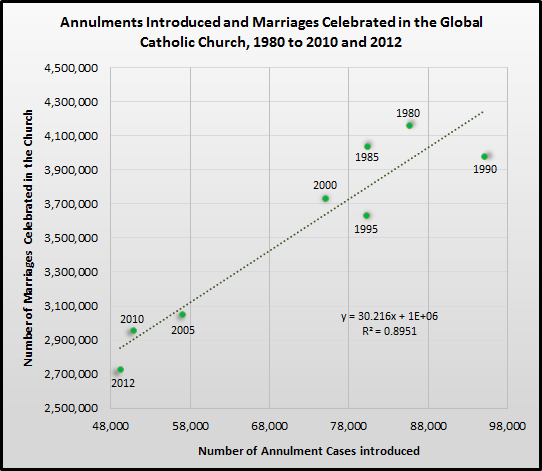Overall, the number of annulments introduced annually has fallen by 43% since 1980 and in 2012 the total number of cases introduced was down to 49,912 of which 24,010 came from the United States (49% of the world total). Generally, the number of annulment cases from the Americas and Oceania are down while the numbers from Europe, Asia, and Africa are up.
There have been some changes to the annulment process since 1980. Now an initial annulment finding (first instance) is reviewed (second instance) before it can become confirmed. To keep the data as comparable as possible the table below compares annulments in 1980 to decrees of nullity for the first instance in 2012. The focus in this table is on cases where a decision has been made whereas the figure above focuses on new cases introduced (many cases cross over from one year to the next). In 1980, 89,065 annulment cases were closed and 68,787 annulments were granted. Thus, annulments made up 77% of all cases closed. That does not mean that in 23% of cases the Church found no grounds for annulment. In many cases the parties quit the process at some point without the Church ever making a determination (e.g., they may reconcile or no longer have interest in an annulment).
In 2012, 49,417 cases were closed (...moving on to the second instance) and the Church ruled in favor of nullity in 40,811 of these cases (83%). There is some regional variations in the likelihood of receiving an annulment. Only 61% of closed cases in Africa resulted in annulment compared to 86% of cases in the Americas. However, this is not because tribunals in Africa were more likely than those in the Americas to rule contrary to nullity. It is more a reflection of more people seeking annulments in Africa than in the Americas not completing the annulment process.
As shown in the figure below, when the number of marriages in the Church decline so do the number of annulment cases.
How can sacramental practice become less common even as the Catholic population continues to grow? One could easily jump to conclusions and consider this to be solely a reflection of "secularization" or a growing preoccupation with the digital world. Yet there is a bit of demography behind these changes as well.
The world's population is aging and you only get baptized or have your first communion once. People are living longer, healthier lives. It is this extension of life that is leading to population growth (...not births as it is so often assumed). Since 1995, now, and through 2050 we have and can continue to expect there to be about 125 million to 134 million births per year worldwide. At the same time, according to the Census Bureau's International Data Base, in 1995 average life expectancy at birth globally was 63. Today it is 69 and in 2050 it is expected to be 76.
When one looks at sacraments celebrated per 1,000 Catholics in a country or a region almost all the trend lines are declining since 1980. This result is driven by people, on average, living longer lives and having fewer children. Fertility rates are falling almost everywhere (Germany is now matching Japan for record low fertility). As the UN's most recent report on the World Population Situation concludes, "patterns of declining fertility and mortality over the past two decades have led to significant shifts in the age structure of the world’s population. ...While rising life expectancy is a success story, population ageing presents a number of challenges to families, communities and societies with respect to issues such as economic growth, economic security in old age, the organization of health care systems and the strength of familial support systems" (pg. 24). You can see the life expectancy and fertility trends, by country, move together below in World Bank data (press play):
If a population has fewer children it will also have fewer baptisms and then fewer marriages, etc. The cycle feeds on itself generation to generation. Few notice any changes in the short term because all this occurs as life expectancy gains boost overall population numbers. Sacramental numbers will inevitably wane given these demographic shifts. Annulment cases will also likely continue to fall regardless of any changes that might be made to the process.



